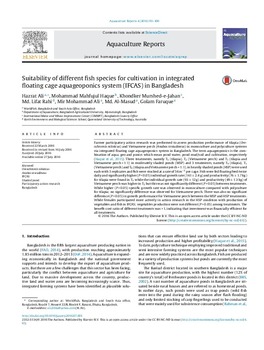Suitability of different fish species for cultivation in integrated floating cage aquageoponics system (IFCAS) in Bangladesh
Abstract
Farmer participatory action research was performed to assess production performance of tilapia (Oreochromis niloticus) and Vietnamese perch (Anabas testudineus) in monoculture and polyculture systems via integrated floating cage aquageoponics system in Bangladesh. The term aquageoponics is the combination of aqua, geo and ponics which mean pond water, pond mud/soil and cultivation, respectively (Haque et al., 2015). Three treatments, namely T1 (tilapia), T2 (Vietnamese perch) and T3 (tilapia and Vietnamese perch = 1:1) in moderately shaded ponds (MSP) and 3 treatments, namely T4 (tilapia), T5 (Vietnamese perch) and T6 (tilapia and Vietnamese perch = 1:1), in heavily shaded ponds (HSP) were used each with 3 replicates and fish were stocked at a rate of 56 m−2 per cage. Fish were fed floating feed twice daily and significantly higher (P 0.05) between treatments. While higher (P > 0.05) specific growth rate was observed in monoculture compared with polyculture for tilapia; no significantly difference was observed for Vietnamese perch. There was also no significant difference (P > 0.05) in growth performance for Vietnamese perch between the MSP and HSP treatments. While females participated more actively in action research in the HSP condition with production of vegetables and fish in IFCAS; vegetables production were not different (P > 0.05) among treatments. The benefit-cost ratio of different treatments was >1, indicating that investment was financially efficient for all treatments

